Analysis of High Performance Work Organization: A Comprehensive Report
VerifiedAdded on 2021/06/17
|17
|4762
|26
Report
AI Summary
This report provides a comprehensive overview of High Performance Work Organizations (HPW), exploring their core concepts and essential components. It delves into the relationship between HPW and sustainable organizational performance, identifying potential barriers to success. The report outlines the stages of the performance management cycle and examines the role of performance reviews, including the involvement of line managers. Furthermore, it discusses how performance management processes contribute to building future organizational capacity. The report concludes with recommendations for creating and sustaining a high-performance work culture, emphasizing the importance of leadership, employee involvement, and reward systems. The report also highlights the significance of a transparent and open communication culture, along with the need for continuous improvement in employee skills and engagement.
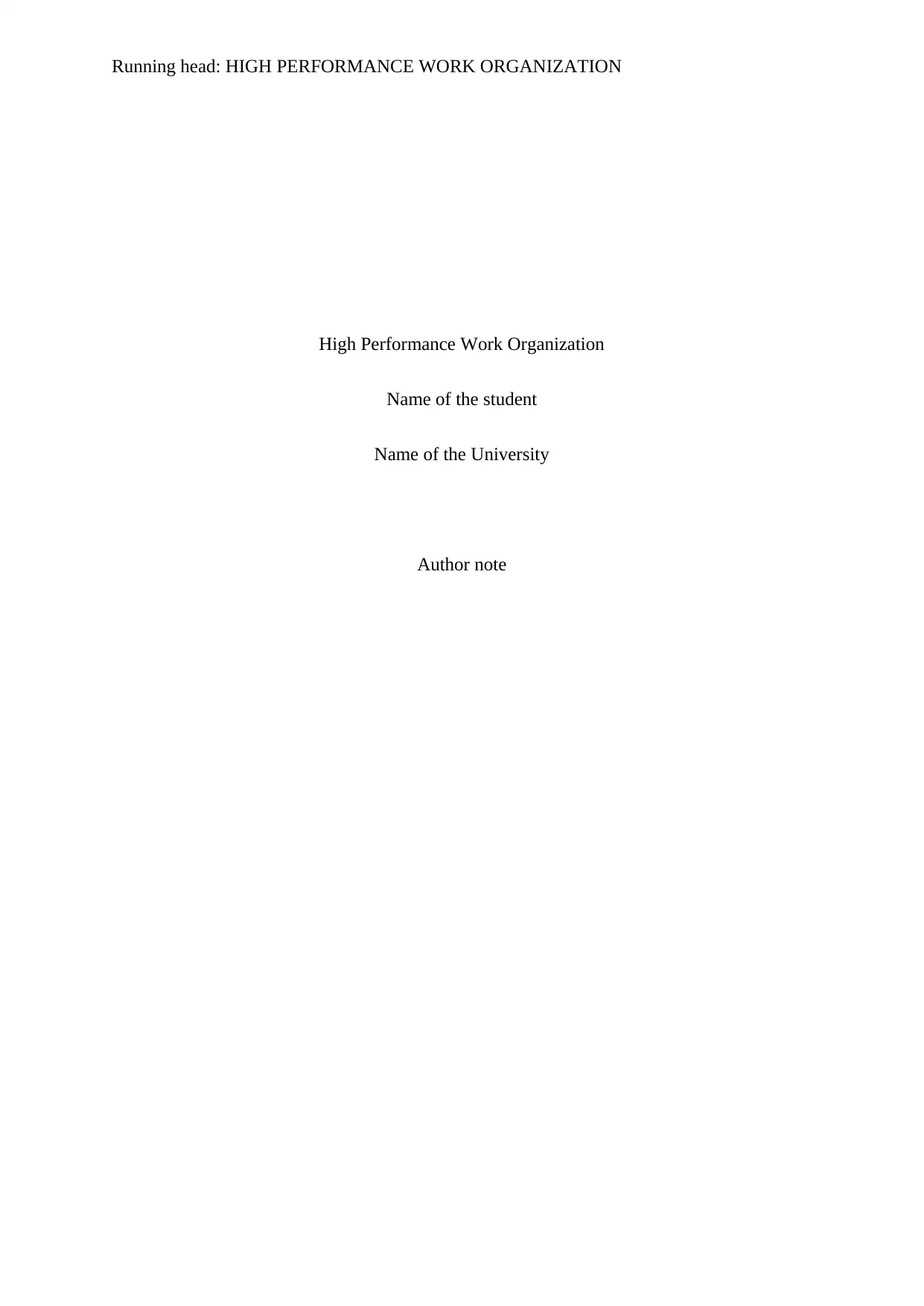
Running head: HIGH PERFORMANCE WORK ORGANIZATION
High Performance Work Organization
Name of the student
Name of the University
Author note
High Performance Work Organization
Name of the student
Name of the University
Author note
Paraphrase This Document
Need a fresh take? Get an instant paraphrase of this document with our AI Paraphraser
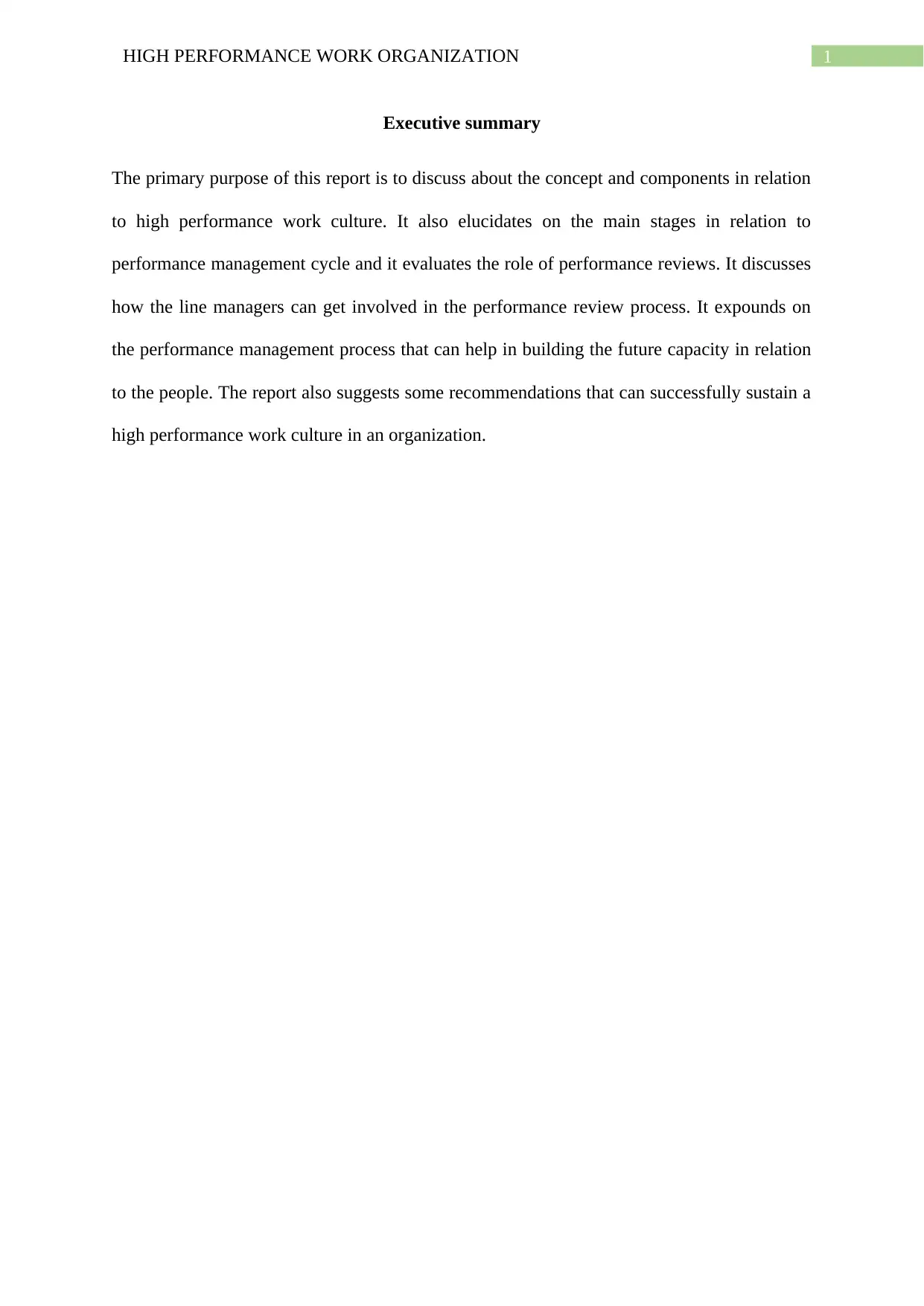
1HIGH PERFORMANCE WORK ORGANIZATION
Executive summary
The primary purpose of this report is to discuss about the concept and components in relation
to high performance work culture. It also elucidates on the main stages in relation to
performance management cycle and it evaluates the role of performance reviews. It discusses
how the line managers can get involved in the performance review process. It expounds on
the performance management process that can help in building the future capacity in relation
to the people. The report also suggests some recommendations that can successfully sustain a
high performance work culture in an organization.
Executive summary
The primary purpose of this report is to discuss about the concept and components in relation
to high performance work culture. It also elucidates on the main stages in relation to
performance management cycle and it evaluates the role of performance reviews. It discusses
how the line managers can get involved in the performance review process. It expounds on
the performance management process that can help in building the future capacity in relation
to the people. The report also suggests some recommendations that can successfully sustain a
high performance work culture in an organization.
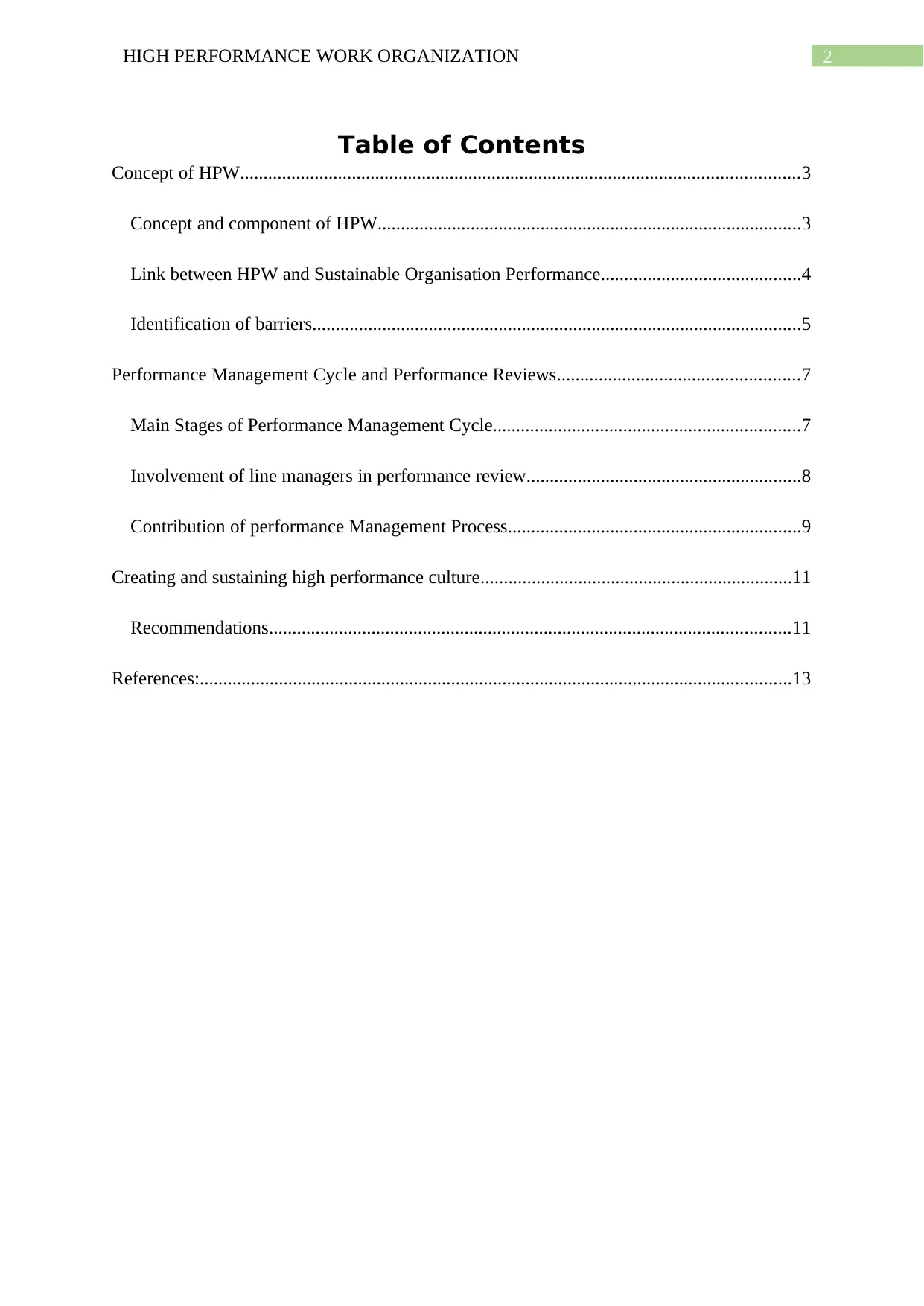
2HIGH PERFORMANCE WORK ORGANIZATION
Table of Contents
Concept of HPW........................................................................................................................3
Concept and component of HPW...........................................................................................3
Link between HPW and Sustainable Organisation Performance...........................................4
Identification of barriers.........................................................................................................5
Performance Management Cycle and Performance Reviews....................................................7
Main Stages of Performance Management Cycle..................................................................7
Involvement of line managers in performance review...........................................................8
Contribution of performance Management Process...............................................................9
Creating and sustaining high performance culture...................................................................11
Recommendations................................................................................................................11
References:...............................................................................................................................13
Table of Contents
Concept of HPW........................................................................................................................3
Concept and component of HPW...........................................................................................3
Link between HPW and Sustainable Organisation Performance...........................................4
Identification of barriers.........................................................................................................5
Performance Management Cycle and Performance Reviews....................................................7
Main Stages of Performance Management Cycle..................................................................7
Involvement of line managers in performance review...........................................................8
Contribution of performance Management Process...............................................................9
Creating and sustaining high performance culture...................................................................11
Recommendations................................................................................................................11
References:...............................................................................................................................13
⊘ This is a preview!⊘
Do you want full access?
Subscribe today to unlock all pages.

Trusted by 1+ million students worldwide
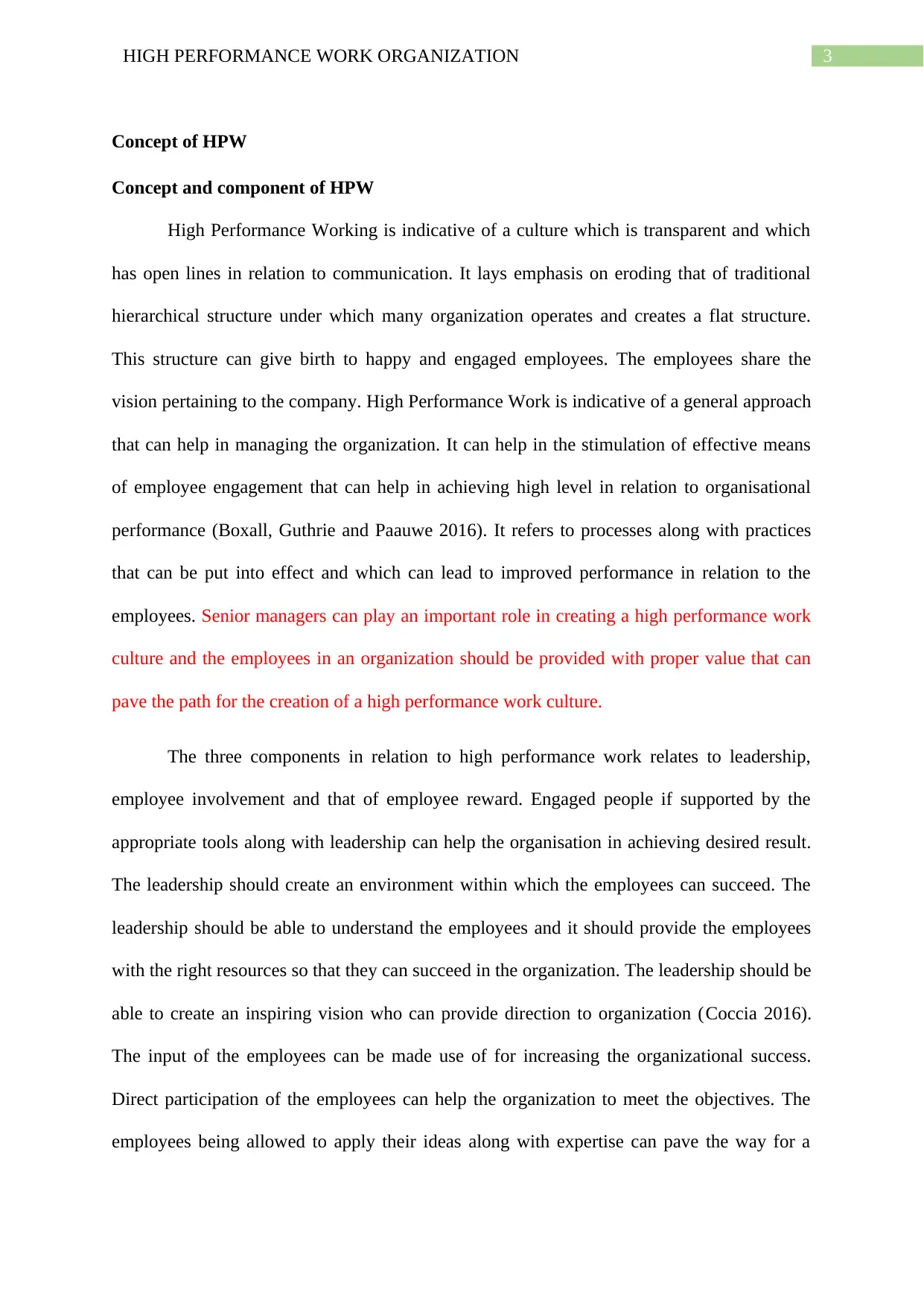
3HIGH PERFORMANCE WORK ORGANIZATION
Concept of HPW
Concept and component of HPW
High Performance Working is indicative of a culture which is transparent and which
has open lines in relation to communication. It lays emphasis on eroding that of traditional
hierarchical structure under which many organization operates and creates a flat structure.
This structure can give birth to happy and engaged employees. The employees share the
vision pertaining to the company. High Performance Work is indicative of a general approach
that can help in managing the organization. It can help in the stimulation of effective means
of employee engagement that can help in achieving high level in relation to organisational
performance (Boxall, Guthrie and Paauwe 2016). It refers to processes along with practices
that can be put into effect and which can lead to improved performance in relation to the
employees. Senior managers can play an important role in creating a high performance work
culture and the employees in an organization should be provided with proper value that can
pave the path for the creation of a high performance work culture.
The three components in relation to high performance work relates to leadership,
employee involvement and that of employee reward. Engaged people if supported by the
appropriate tools along with leadership can help the organisation in achieving desired result.
The leadership should create an environment within which the employees can succeed. The
leadership should be able to understand the employees and it should provide the employees
with the right resources so that they can succeed in the organization. The leadership should be
able to create an inspiring vision who can provide direction to organization (Coccia 2016).
The input of the employees can be made use of for increasing the organizational success.
Direct participation of the employees can help the organization to meet the objectives. The
employees being allowed to apply their ideas along with expertise can pave the way for a
Concept of HPW
Concept and component of HPW
High Performance Working is indicative of a culture which is transparent and which
has open lines in relation to communication. It lays emphasis on eroding that of traditional
hierarchical structure under which many organization operates and creates a flat structure.
This structure can give birth to happy and engaged employees. The employees share the
vision pertaining to the company. High Performance Work is indicative of a general approach
that can help in managing the organization. It can help in the stimulation of effective means
of employee engagement that can help in achieving high level in relation to organisational
performance (Boxall, Guthrie and Paauwe 2016). It refers to processes along with practices
that can be put into effect and which can lead to improved performance in relation to the
employees. Senior managers can play an important role in creating a high performance work
culture and the employees in an organization should be provided with proper value that can
pave the path for the creation of a high performance work culture.
The three components in relation to high performance work relates to leadership,
employee involvement and that of employee reward. Engaged people if supported by the
appropriate tools along with leadership can help the organisation in achieving desired result.
The leadership should create an environment within which the employees can succeed. The
leadership should be able to understand the employees and it should provide the employees
with the right resources so that they can succeed in the organization. The leadership should be
able to create an inspiring vision who can provide direction to organization (Coccia 2016).
The input of the employees can be made use of for increasing the organizational success.
Direct participation of the employees can help the organization to meet the objectives. The
employees being allowed to apply their ideas along with expertise can pave the way for a
Paraphrase This Document
Need a fresh take? Get an instant paraphrase of this document with our AI Paraphraser
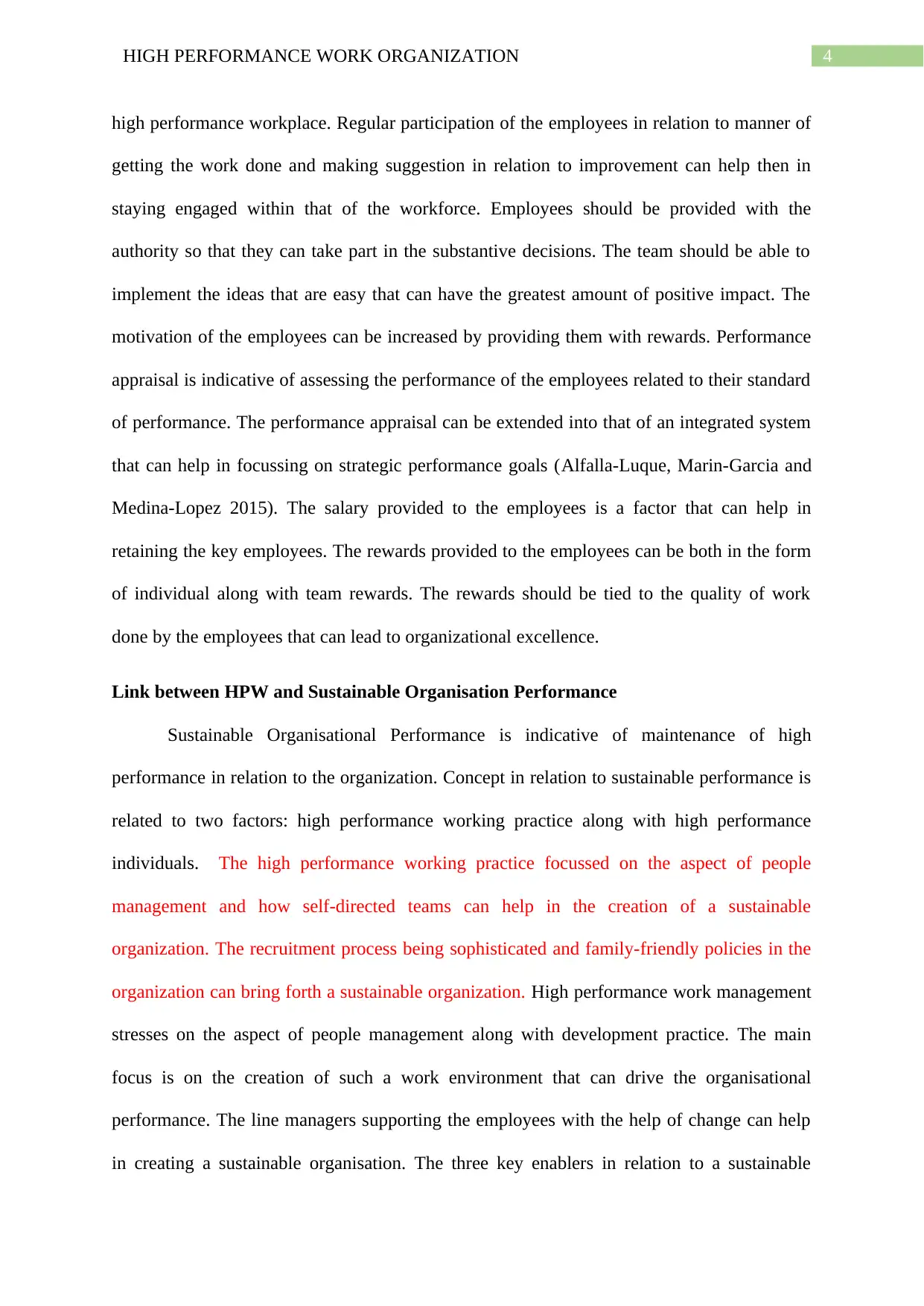
4HIGH PERFORMANCE WORK ORGANIZATION
high performance workplace. Regular participation of the employees in relation to manner of
getting the work done and making suggestion in relation to improvement can help then in
staying engaged within that of the workforce. Employees should be provided with the
authority so that they can take part in the substantive decisions. The team should be able to
implement the ideas that are easy that can have the greatest amount of positive impact. The
motivation of the employees can be increased by providing them with rewards. Performance
appraisal is indicative of assessing the performance of the employees related to their standard
of performance. The performance appraisal can be extended into that of an integrated system
that can help in focussing on strategic performance goals (Alfalla-Luque, Marin-Garcia and
Medina-Lopez 2015). The salary provided to the employees is a factor that can help in
retaining the key employees. The rewards provided to the employees can be both in the form
of individual along with team rewards. The rewards should be tied to the quality of work
done by the employees that can lead to organizational excellence.
Link between HPW and Sustainable Organisation Performance
Sustainable Organisational Performance is indicative of maintenance of high
performance in relation to the organization. Concept in relation to sustainable performance is
related to two factors: high performance working practice along with high performance
individuals. The high performance working practice focussed on the aspect of people
management and how self-directed teams can help in the creation of a sustainable
organization. The recruitment process being sophisticated and family-friendly policies in the
organization can bring forth a sustainable organization. High performance work management
stresses on the aspect of people management along with development practice. The main
focus is on the creation of such a work environment that can drive the organisational
performance. The line managers supporting the employees with the help of change can help
in creating a sustainable organisation. The three key enablers in relation to a sustainable
high performance workplace. Regular participation of the employees in relation to manner of
getting the work done and making suggestion in relation to improvement can help then in
staying engaged within that of the workforce. Employees should be provided with the
authority so that they can take part in the substantive decisions. The team should be able to
implement the ideas that are easy that can have the greatest amount of positive impact. The
motivation of the employees can be increased by providing them with rewards. Performance
appraisal is indicative of assessing the performance of the employees related to their standard
of performance. The performance appraisal can be extended into that of an integrated system
that can help in focussing on strategic performance goals (Alfalla-Luque, Marin-Garcia and
Medina-Lopez 2015). The salary provided to the employees is a factor that can help in
retaining the key employees. The rewards provided to the employees can be both in the form
of individual along with team rewards. The rewards should be tied to the quality of work
done by the employees that can lead to organizational excellence.
Link between HPW and Sustainable Organisation Performance
Sustainable Organisational Performance is indicative of maintenance of high
performance in relation to the organization. Concept in relation to sustainable performance is
related to two factors: high performance working practice along with high performance
individuals. The high performance working practice focussed on the aspect of people
management and how self-directed teams can help in the creation of a sustainable
organization. The recruitment process being sophisticated and family-friendly policies in the
organization can bring forth a sustainable organization. High performance work management
stresses on the aspect of people management along with development practice. The main
focus is on the creation of such a work environment that can drive the organisational
performance. The line managers supporting the employees with the help of change can help
in creating a sustainable organisation. The three key enablers in relation to a sustainable
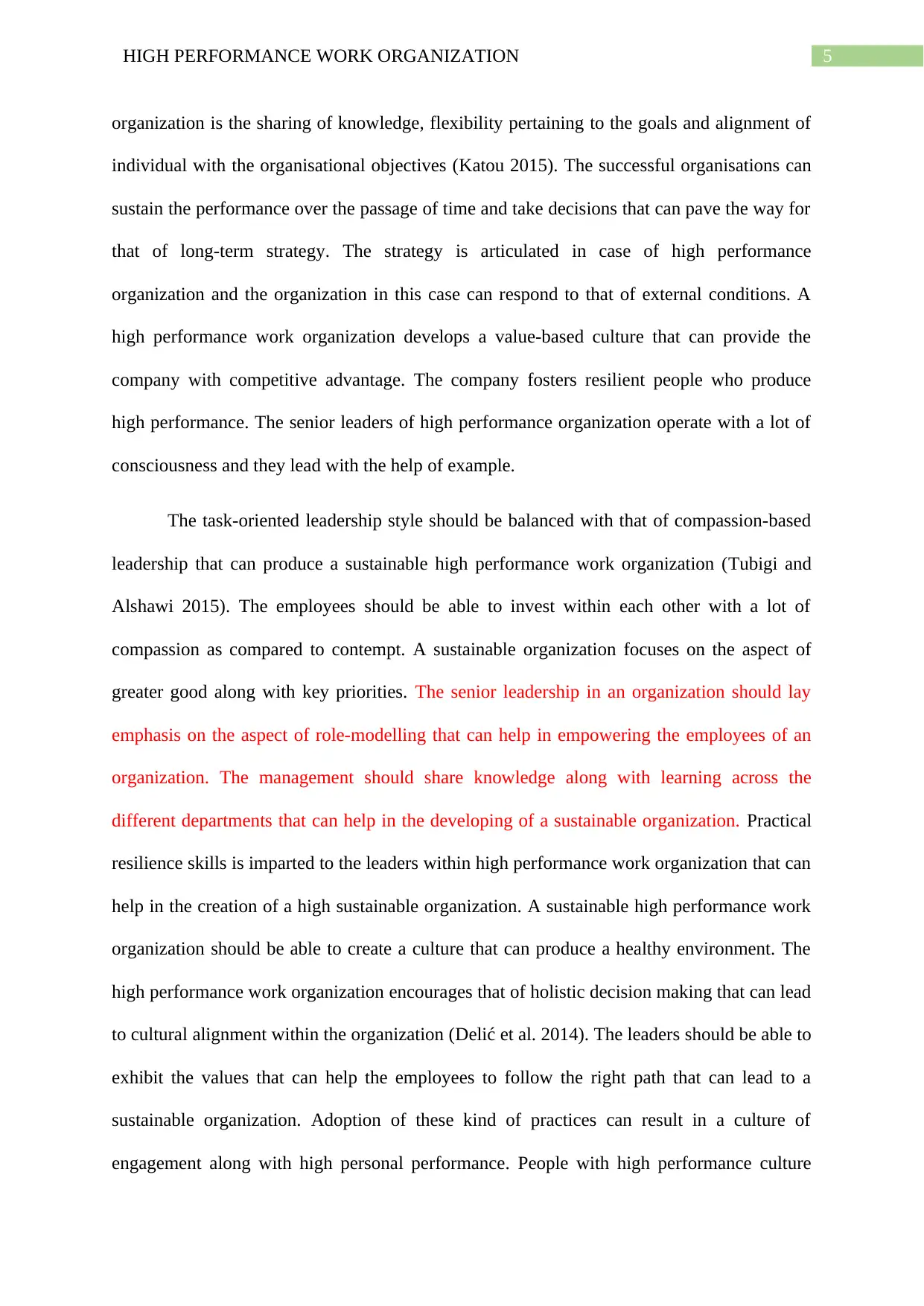
5HIGH PERFORMANCE WORK ORGANIZATION
organization is the sharing of knowledge, flexibility pertaining to the goals and alignment of
individual with the organisational objectives (Katou 2015). The successful organisations can
sustain the performance over the passage of time and take decisions that can pave the way for
that of long-term strategy. The strategy is articulated in case of high performance
organization and the organization in this case can respond to that of external conditions. A
high performance work organization develops a value-based culture that can provide the
company with competitive advantage. The company fosters resilient people who produce
high performance. The senior leaders of high performance organization operate with a lot of
consciousness and they lead with the help of example.
The task-oriented leadership style should be balanced with that of compassion-based
leadership that can produce a sustainable high performance work organization (Tubigi and
Alshawi 2015). The employees should be able to invest within each other with a lot of
compassion as compared to contempt. A sustainable organization focuses on the aspect of
greater good along with key priorities. The senior leadership in an organization should lay
emphasis on the aspect of role-modelling that can help in empowering the employees of an
organization. The management should share knowledge along with learning across the
different departments that can help in the developing of a sustainable organization. Practical
resilience skills is imparted to the leaders within high performance work organization that can
help in the creation of a high sustainable organization. A sustainable high performance work
organization should be able to create a culture that can produce a healthy environment. The
high performance work organization encourages that of holistic decision making that can lead
to cultural alignment within the organization (Delić et al. 2014). The leaders should be able to
exhibit the values that can help the employees to follow the right path that can lead to a
sustainable organization. Adoption of these kind of practices can result in a culture of
engagement along with high personal performance. People with high performance culture
organization is the sharing of knowledge, flexibility pertaining to the goals and alignment of
individual with the organisational objectives (Katou 2015). The successful organisations can
sustain the performance over the passage of time and take decisions that can pave the way for
that of long-term strategy. The strategy is articulated in case of high performance
organization and the organization in this case can respond to that of external conditions. A
high performance work organization develops a value-based culture that can provide the
company with competitive advantage. The company fosters resilient people who produce
high performance. The senior leaders of high performance organization operate with a lot of
consciousness and they lead with the help of example.
The task-oriented leadership style should be balanced with that of compassion-based
leadership that can produce a sustainable high performance work organization (Tubigi and
Alshawi 2015). The employees should be able to invest within each other with a lot of
compassion as compared to contempt. A sustainable organization focuses on the aspect of
greater good along with key priorities. The senior leadership in an organization should lay
emphasis on the aspect of role-modelling that can help in empowering the employees of an
organization. The management should share knowledge along with learning across the
different departments that can help in the developing of a sustainable organization. Practical
resilience skills is imparted to the leaders within high performance work organization that can
help in the creation of a high sustainable organization. A sustainable high performance work
organization should be able to create a culture that can produce a healthy environment. The
high performance work organization encourages that of holistic decision making that can lead
to cultural alignment within the organization (Delić et al. 2014). The leaders should be able to
exhibit the values that can help the employees to follow the right path that can lead to a
sustainable organization. Adoption of these kind of practices can result in a culture of
engagement along with high personal performance. People with high performance culture
⊘ This is a preview!⊘
Do you want full access?
Subscribe today to unlock all pages.

Trusted by 1+ million students worldwide
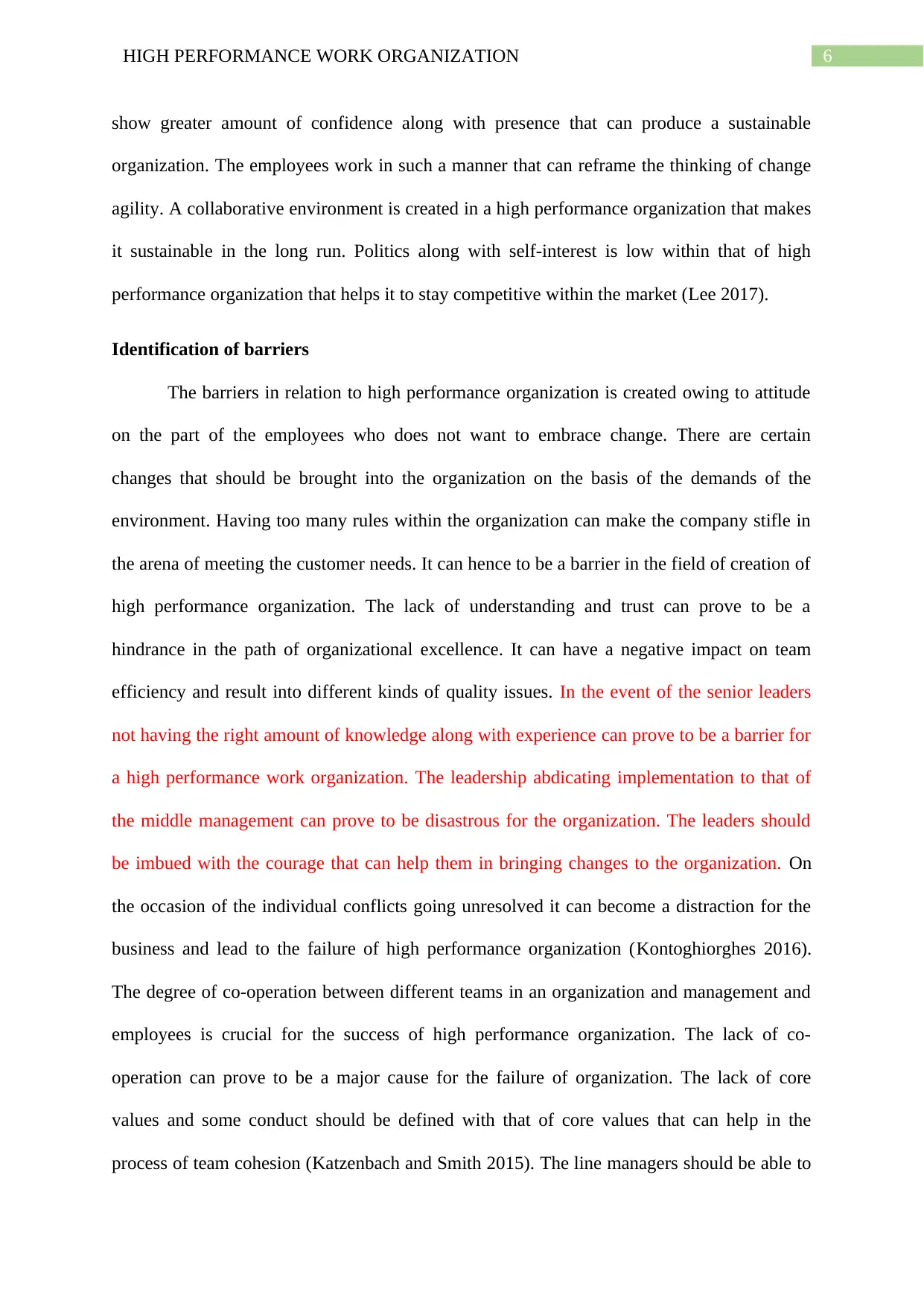
6HIGH PERFORMANCE WORK ORGANIZATION
show greater amount of confidence along with presence that can produce a sustainable
organization. The employees work in such a manner that can reframe the thinking of change
agility. A collaborative environment is created in a high performance organization that makes
it sustainable in the long run. Politics along with self-interest is low within that of high
performance organization that helps it to stay competitive within the market (Lee 2017).
Identification of barriers
The barriers in relation to high performance organization is created owing to attitude
on the part of the employees who does not want to embrace change. There are certain
changes that should be brought into the organization on the basis of the demands of the
environment. Having too many rules within the organization can make the company stifle in
the arena of meeting the customer needs. It can hence to be a barrier in the field of creation of
high performance organization. The lack of understanding and trust can prove to be a
hindrance in the path of organizational excellence. It can have a negative impact on team
efficiency and result into different kinds of quality issues. In the event of the senior leaders
not having the right amount of knowledge along with experience can prove to be a barrier for
a high performance work organization. The leadership abdicating implementation to that of
the middle management can prove to be disastrous for the organization. The leaders should
be imbued with the courage that can help them in bringing changes to the organization. On
the occasion of the individual conflicts going unresolved it can become a distraction for the
business and lead to the failure of high performance organization (Kontoghiorghes 2016).
The degree of co-operation between different teams in an organization and management and
employees is crucial for the success of high performance organization. The lack of co-
operation can prove to be a major cause for the failure of organization. The lack of core
values and some conduct should be defined with that of core values that can help in the
process of team cohesion (Katzenbach and Smith 2015). The line managers should be able to
show greater amount of confidence along with presence that can produce a sustainable
organization. The employees work in such a manner that can reframe the thinking of change
agility. A collaborative environment is created in a high performance organization that makes
it sustainable in the long run. Politics along with self-interest is low within that of high
performance organization that helps it to stay competitive within the market (Lee 2017).
Identification of barriers
The barriers in relation to high performance organization is created owing to attitude
on the part of the employees who does not want to embrace change. There are certain
changes that should be brought into the organization on the basis of the demands of the
environment. Having too many rules within the organization can make the company stifle in
the arena of meeting the customer needs. It can hence to be a barrier in the field of creation of
high performance organization. The lack of understanding and trust can prove to be a
hindrance in the path of organizational excellence. It can have a negative impact on team
efficiency and result into different kinds of quality issues. In the event of the senior leaders
not having the right amount of knowledge along with experience can prove to be a barrier for
a high performance work organization. The leadership abdicating implementation to that of
the middle management can prove to be disastrous for the organization. The leaders should
be imbued with the courage that can help them in bringing changes to the organization. On
the occasion of the individual conflicts going unresolved it can become a distraction for the
business and lead to the failure of high performance organization (Kontoghiorghes 2016).
The degree of co-operation between different teams in an organization and management and
employees is crucial for the success of high performance organization. The lack of co-
operation can prove to be a major cause for the failure of organization. The lack of core
values and some conduct should be defined with that of core values that can help in the
process of team cohesion (Katzenbach and Smith 2015). The line managers should be able to
Paraphrase This Document
Need a fresh take? Get an instant paraphrase of this document with our AI Paraphraser
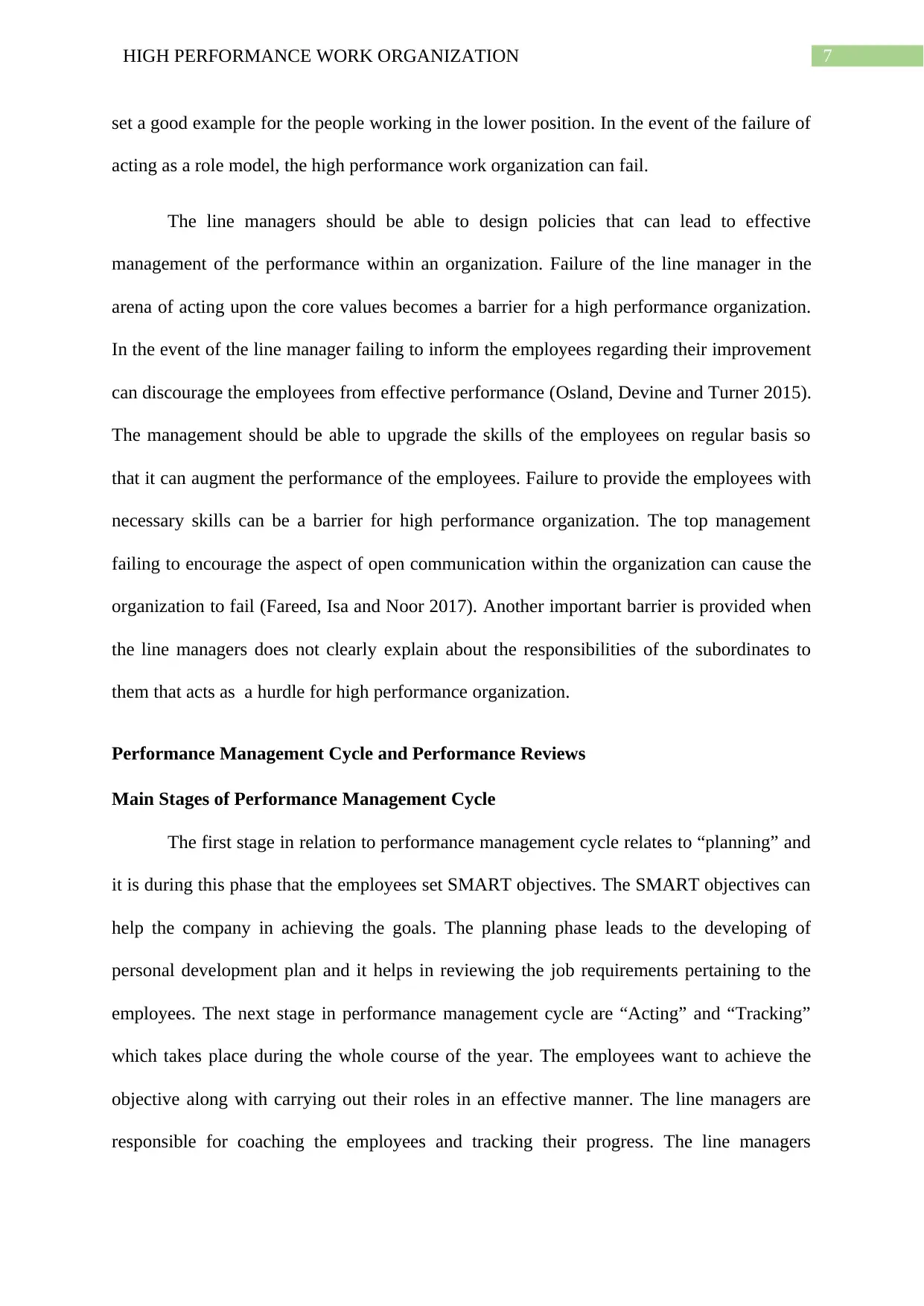
7HIGH PERFORMANCE WORK ORGANIZATION
set a good example for the people working in the lower position. In the event of the failure of
acting as a role model, the high performance work organization can fail.
The line managers should be able to design policies that can lead to effective
management of the performance within an organization. Failure of the line manager in the
arena of acting upon the core values becomes a barrier for a high performance organization.
In the event of the line manager failing to inform the employees regarding their improvement
can discourage the employees from effective performance (Osland, Devine and Turner 2015).
The management should be able to upgrade the skills of the employees on regular basis so
that it can augment the performance of the employees. Failure to provide the employees with
necessary skills can be a barrier for high performance organization. The top management
failing to encourage the aspect of open communication within the organization can cause the
organization to fail (Fareed, Isa and Noor 2017). Another important barrier is provided when
the line managers does not clearly explain about the responsibilities of the subordinates to
them that acts as a hurdle for high performance organization.
Performance Management Cycle and Performance Reviews
Main Stages of Performance Management Cycle
The first stage in relation to performance management cycle relates to “planning” and
it is during this phase that the employees set SMART objectives. The SMART objectives can
help the company in achieving the goals. The planning phase leads to the developing of
personal development plan and it helps in reviewing the job requirements pertaining to the
employees. The next stage in performance management cycle are “Acting” and “Tracking”
which takes place during the whole course of the year. The employees want to achieve the
objective along with carrying out their roles in an effective manner. The line managers are
responsible for coaching the employees and tracking their progress. The line managers
set a good example for the people working in the lower position. In the event of the failure of
acting as a role model, the high performance work organization can fail.
The line managers should be able to design policies that can lead to effective
management of the performance within an organization. Failure of the line manager in the
arena of acting upon the core values becomes a barrier for a high performance organization.
In the event of the line manager failing to inform the employees regarding their improvement
can discourage the employees from effective performance (Osland, Devine and Turner 2015).
The management should be able to upgrade the skills of the employees on regular basis so
that it can augment the performance of the employees. Failure to provide the employees with
necessary skills can be a barrier for high performance organization. The top management
failing to encourage the aspect of open communication within the organization can cause the
organization to fail (Fareed, Isa and Noor 2017). Another important barrier is provided when
the line managers does not clearly explain about the responsibilities of the subordinates to
them that acts as a hurdle for high performance organization.
Performance Management Cycle and Performance Reviews
Main Stages of Performance Management Cycle
The first stage in relation to performance management cycle relates to “planning” and
it is during this phase that the employees set SMART objectives. The SMART objectives can
help the company in achieving the goals. The planning phase leads to the developing of
personal development plan and it helps in reviewing the job requirements pertaining to the
employees. The next stage in performance management cycle are “Acting” and “Tracking”
which takes place during the whole course of the year. The employees want to achieve the
objective along with carrying out their roles in an effective manner. The line managers are
responsible for coaching the employees and tracking their progress. The line managers
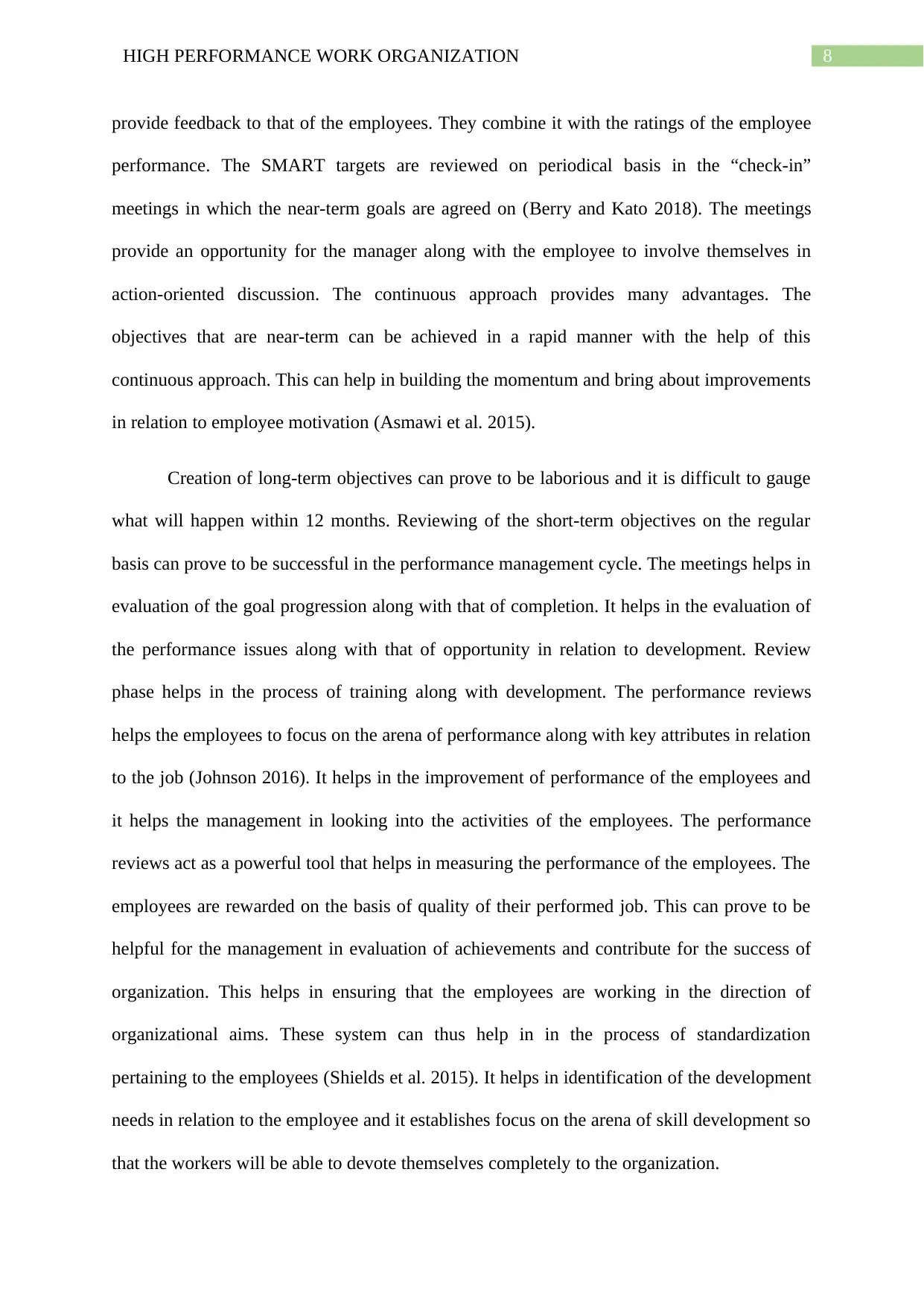
8HIGH PERFORMANCE WORK ORGANIZATION
provide feedback to that of the employees. They combine it with the ratings of the employee
performance. The SMART targets are reviewed on periodical basis in the “check-in”
meetings in which the near-term goals are agreed on (Berry and Kato 2018). The meetings
provide an opportunity for the manager along with the employee to involve themselves in
action-oriented discussion. The continuous approach provides many advantages. The
objectives that are near-term can be achieved in a rapid manner with the help of this
continuous approach. This can help in building the momentum and bring about improvements
in relation to employee motivation (Asmawi et al. 2015).
Creation of long-term objectives can prove to be laborious and it is difficult to gauge
what will happen within 12 months. Reviewing of the short-term objectives on the regular
basis can prove to be successful in the performance management cycle. The meetings helps in
evaluation of the goal progression along with that of completion. It helps in the evaluation of
the performance issues along with that of opportunity in relation to development. Review
phase helps in the process of training along with development. The performance reviews
helps the employees to focus on the arena of performance along with key attributes in relation
to the job (Johnson 2016). It helps in the improvement of performance of the employees and
it helps the management in looking into the activities of the employees. The performance
reviews act as a powerful tool that helps in measuring the performance of the employees. The
employees are rewarded on the basis of quality of their performed job. This can prove to be
helpful for the management in evaluation of achievements and contribute for the success of
organization. This helps in ensuring that the employees are working in the direction of
organizational aims. These system can thus help in in the process of standardization
pertaining to the employees (Shields et al. 2015). It helps in identification of the development
needs in relation to the employee and it establishes focus on the arena of skill development so
that the workers will be able to devote themselves completely to the organization.
provide feedback to that of the employees. They combine it with the ratings of the employee
performance. The SMART targets are reviewed on periodical basis in the “check-in”
meetings in which the near-term goals are agreed on (Berry and Kato 2018). The meetings
provide an opportunity for the manager along with the employee to involve themselves in
action-oriented discussion. The continuous approach provides many advantages. The
objectives that are near-term can be achieved in a rapid manner with the help of this
continuous approach. This can help in building the momentum and bring about improvements
in relation to employee motivation (Asmawi et al. 2015).
Creation of long-term objectives can prove to be laborious and it is difficult to gauge
what will happen within 12 months. Reviewing of the short-term objectives on the regular
basis can prove to be successful in the performance management cycle. The meetings helps in
evaluation of the goal progression along with that of completion. It helps in the evaluation of
the performance issues along with that of opportunity in relation to development. Review
phase helps in the process of training along with development. The performance reviews
helps the employees to focus on the arena of performance along with key attributes in relation
to the job (Johnson 2016). It helps in the improvement of performance of the employees and
it helps the management in looking into the activities of the employees. The performance
reviews act as a powerful tool that helps in measuring the performance of the employees. The
employees are rewarded on the basis of quality of their performed job. This can prove to be
helpful for the management in evaluation of achievements and contribute for the success of
organization. This helps in ensuring that the employees are working in the direction of
organizational aims. These system can thus help in in the process of standardization
pertaining to the employees (Shields et al. 2015). It helps in identification of the development
needs in relation to the employee and it establishes focus on the arena of skill development so
that the workers will be able to devote themselves completely to the organization.
⊘ This is a preview!⊘
Do you want full access?
Subscribe today to unlock all pages.

Trusted by 1+ million students worldwide
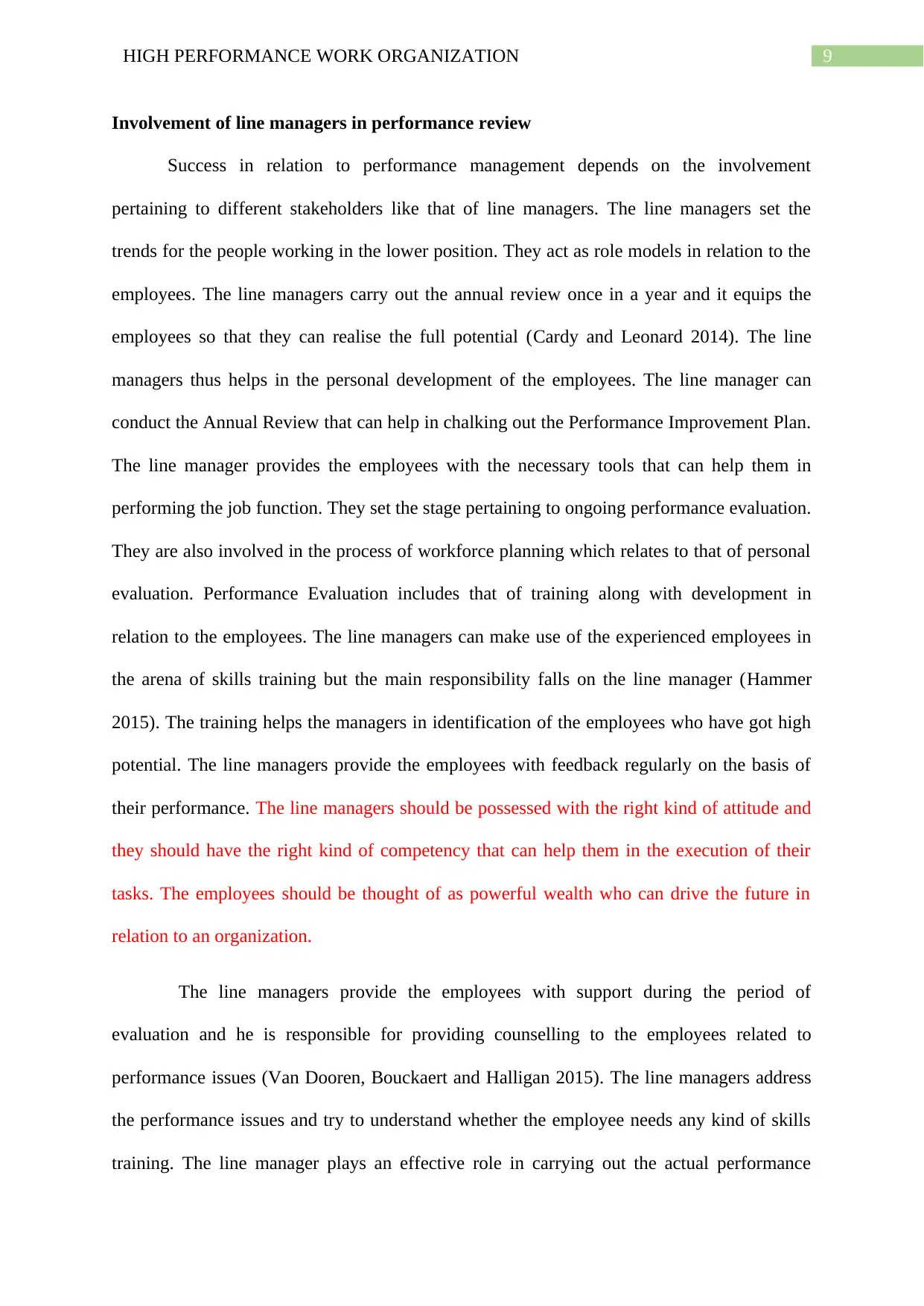
9HIGH PERFORMANCE WORK ORGANIZATION
Involvement of line managers in performance review
Success in relation to performance management depends on the involvement
pertaining to different stakeholders like that of line managers. The line managers set the
trends for the people working in the lower position. They act as role models in relation to the
employees. The line managers carry out the annual review once in a year and it equips the
employees so that they can realise the full potential (Cardy and Leonard 2014). The line
managers thus helps in the personal development of the employees. The line manager can
conduct the Annual Review that can help in chalking out the Performance Improvement Plan.
The line manager provides the employees with the necessary tools that can help them in
performing the job function. They set the stage pertaining to ongoing performance evaluation.
They are also involved in the process of workforce planning which relates to that of personal
evaluation. Performance Evaluation includes that of training along with development in
relation to the employees. The line managers can make use of the experienced employees in
the arena of skills training but the main responsibility falls on the line manager (Hammer
2015). The training helps the managers in identification of the employees who have got high
potential. The line managers provide the employees with feedback regularly on the basis of
their performance. The line managers should be possessed with the right kind of attitude and
they should have the right kind of competency that can help them in the execution of their
tasks. The employees should be thought of as powerful wealth who can drive the future in
relation to an organization.
The line managers provide the employees with support during the period of
evaluation and he is responsible for providing counselling to the employees related to
performance issues (Van Dooren, Bouckaert and Halligan 2015). The line managers address
the performance issues and try to understand whether the employee needs any kind of skills
training. The line manager plays an effective role in carrying out the actual performance
Involvement of line managers in performance review
Success in relation to performance management depends on the involvement
pertaining to different stakeholders like that of line managers. The line managers set the
trends for the people working in the lower position. They act as role models in relation to the
employees. The line managers carry out the annual review once in a year and it equips the
employees so that they can realise the full potential (Cardy and Leonard 2014). The line
managers thus helps in the personal development of the employees. The line manager can
conduct the Annual Review that can help in chalking out the Performance Improvement Plan.
The line manager provides the employees with the necessary tools that can help them in
performing the job function. They set the stage pertaining to ongoing performance evaluation.
They are also involved in the process of workforce planning which relates to that of personal
evaluation. Performance Evaluation includes that of training along with development in
relation to the employees. The line managers can make use of the experienced employees in
the arena of skills training but the main responsibility falls on the line manager (Hammer
2015). The training helps the managers in identification of the employees who have got high
potential. The line managers provide the employees with feedback regularly on the basis of
their performance. The line managers should be possessed with the right kind of attitude and
they should have the right kind of competency that can help them in the execution of their
tasks. The employees should be thought of as powerful wealth who can drive the future in
relation to an organization.
The line managers provide the employees with support during the period of
evaluation and he is responsible for providing counselling to the employees related to
performance issues (Van Dooren, Bouckaert and Halligan 2015). The line managers address
the performance issues and try to understand whether the employee needs any kind of skills
training. The line manager plays an effective role in carrying out the actual performance
Paraphrase This Document
Need a fresh take? Get an instant paraphrase of this document with our AI Paraphraser
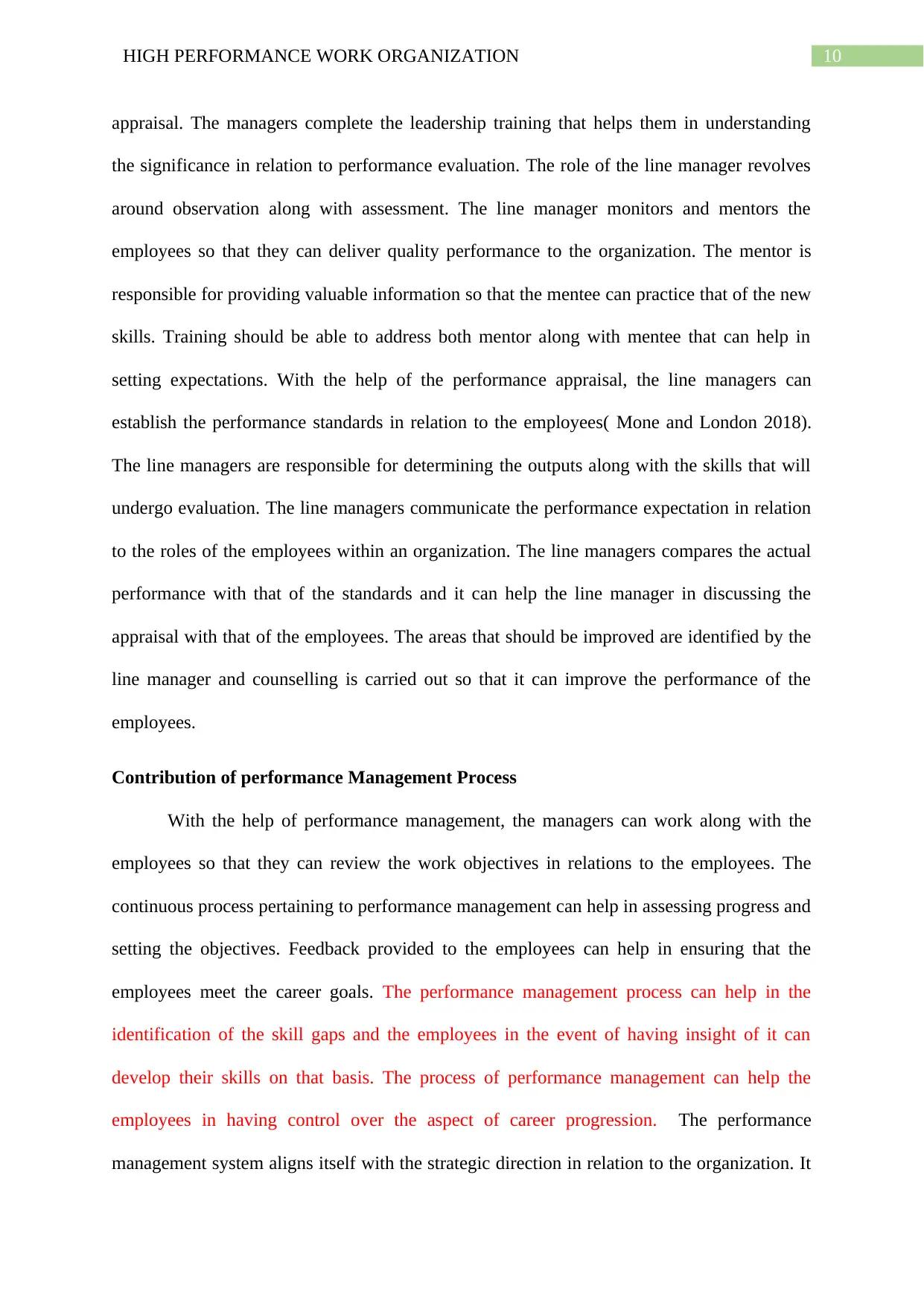
10HIGH PERFORMANCE WORK ORGANIZATION
appraisal. The managers complete the leadership training that helps them in understanding
the significance in relation to performance evaluation. The role of the line manager revolves
around observation along with assessment. The line manager monitors and mentors the
employees so that they can deliver quality performance to the organization. The mentor is
responsible for providing valuable information so that the mentee can practice that of the new
skills. Training should be able to address both mentor along with mentee that can help in
setting expectations. With the help of the performance appraisal, the line managers can
establish the performance standards in relation to the employees( Mone and London 2018).
The line managers are responsible for determining the outputs along with the skills that will
undergo evaluation. The line managers communicate the performance expectation in relation
to the roles of the employees within an organization. The line managers compares the actual
performance with that of the standards and it can help the line manager in discussing the
appraisal with that of the employees. The areas that should be improved are identified by the
line manager and counselling is carried out so that it can improve the performance of the
employees.
Contribution of performance Management Process
With the help of performance management, the managers can work along with the
employees so that they can review the work objectives in relations to the employees. The
continuous process pertaining to performance management can help in assessing progress and
setting the objectives. Feedback provided to the employees can help in ensuring that the
employees meet the career goals. The performance management process can help in the
identification of the skill gaps and the employees in the event of having insight of it can
develop their skills on that basis. The process of performance management can help the
employees in having control over the aspect of career progression. The performance
management system aligns itself with the strategic direction in relation to the organization. It
appraisal. The managers complete the leadership training that helps them in understanding
the significance in relation to performance evaluation. The role of the line manager revolves
around observation along with assessment. The line manager monitors and mentors the
employees so that they can deliver quality performance to the organization. The mentor is
responsible for providing valuable information so that the mentee can practice that of the new
skills. Training should be able to address both mentor along with mentee that can help in
setting expectations. With the help of the performance appraisal, the line managers can
establish the performance standards in relation to the employees( Mone and London 2018).
The line managers are responsible for determining the outputs along with the skills that will
undergo evaluation. The line managers communicate the performance expectation in relation
to the roles of the employees within an organization. The line managers compares the actual
performance with that of the standards and it can help the line manager in discussing the
appraisal with that of the employees. The areas that should be improved are identified by the
line manager and counselling is carried out so that it can improve the performance of the
employees.
Contribution of performance Management Process
With the help of performance management, the managers can work along with the
employees so that they can review the work objectives in relations to the employees. The
continuous process pertaining to performance management can help in assessing progress and
setting the objectives. Feedback provided to the employees can help in ensuring that the
employees meet the career goals. The performance management process can help in the
identification of the skill gaps and the employees in the event of having insight of it can
develop their skills on that basis. The process of performance management can help the
employees in having control over the aspect of career progression. The performance
management system aligns itself with the strategic direction in relation to the organization. It
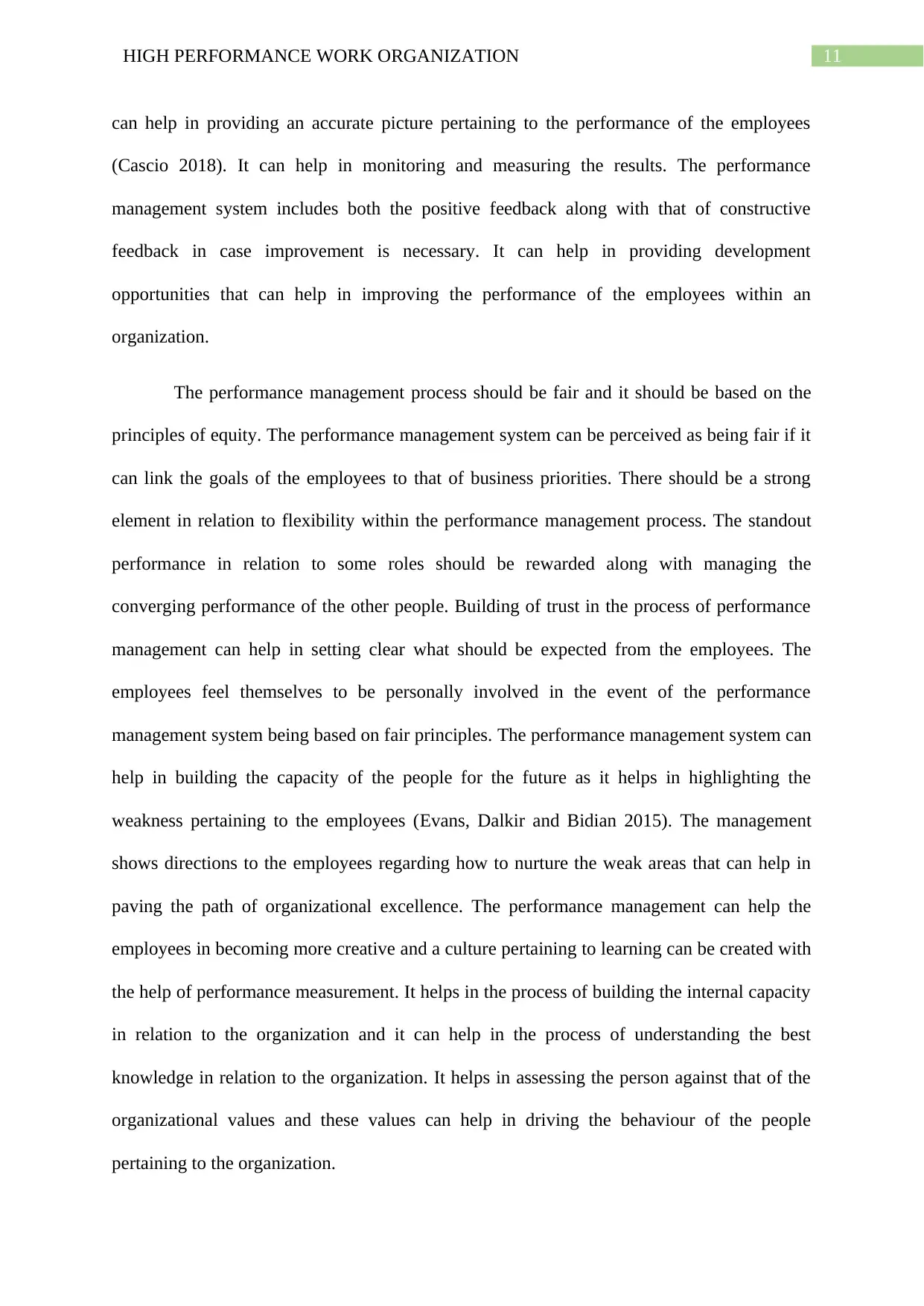
11HIGH PERFORMANCE WORK ORGANIZATION
can help in providing an accurate picture pertaining to the performance of the employees
(Cascio 2018). It can help in monitoring and measuring the results. The performance
management system includes both the positive feedback along with that of constructive
feedback in case improvement is necessary. It can help in providing development
opportunities that can help in improving the performance of the employees within an
organization.
The performance management process should be fair and it should be based on the
principles of equity. The performance management system can be perceived as being fair if it
can link the goals of the employees to that of business priorities. There should be a strong
element in relation to flexibility within the performance management process. The standout
performance in relation to some roles should be rewarded along with managing the
converging performance of the other people. Building of trust in the process of performance
management can help in setting clear what should be expected from the employees. The
employees feel themselves to be personally involved in the event of the performance
management system being based on fair principles. The performance management system can
help in building the capacity of the people for the future as it helps in highlighting the
weakness pertaining to the employees (Evans, Dalkir and Bidian 2015). The management
shows directions to the employees regarding how to nurture the weak areas that can help in
paving the path of organizational excellence. The performance management can help the
employees in becoming more creative and a culture pertaining to learning can be created with
the help of performance measurement. It helps in the process of building the internal capacity
in relation to the organization and it can help in the process of understanding the best
knowledge in relation to the organization. It helps in assessing the person against that of the
organizational values and these values can help in driving the behaviour of the people
pertaining to the organization.
can help in providing an accurate picture pertaining to the performance of the employees
(Cascio 2018). It can help in monitoring and measuring the results. The performance
management system includes both the positive feedback along with that of constructive
feedback in case improvement is necessary. It can help in providing development
opportunities that can help in improving the performance of the employees within an
organization.
The performance management process should be fair and it should be based on the
principles of equity. The performance management system can be perceived as being fair if it
can link the goals of the employees to that of business priorities. There should be a strong
element in relation to flexibility within the performance management process. The standout
performance in relation to some roles should be rewarded along with managing the
converging performance of the other people. Building of trust in the process of performance
management can help in setting clear what should be expected from the employees. The
employees feel themselves to be personally involved in the event of the performance
management system being based on fair principles. The performance management system can
help in building the capacity of the people for the future as it helps in highlighting the
weakness pertaining to the employees (Evans, Dalkir and Bidian 2015). The management
shows directions to the employees regarding how to nurture the weak areas that can help in
paving the path of organizational excellence. The performance management can help the
employees in becoming more creative and a culture pertaining to learning can be created with
the help of performance measurement. It helps in the process of building the internal capacity
in relation to the organization and it can help in the process of understanding the best
knowledge in relation to the organization. It helps in assessing the person against that of the
organizational values and these values can help in driving the behaviour of the people
pertaining to the organization.
⊘ This is a preview!⊘
Do you want full access?
Subscribe today to unlock all pages.

Trusted by 1+ million students worldwide
1 out of 17
Related Documents
Your All-in-One AI-Powered Toolkit for Academic Success.
+13062052269
info@desklib.com
Available 24*7 on WhatsApp / Email
![[object Object]](/_next/static/media/star-bottom.7253800d.svg)
Unlock your academic potential
Copyright © 2020–2025 A2Z Services. All Rights Reserved. Developed and managed by ZUCOL.




